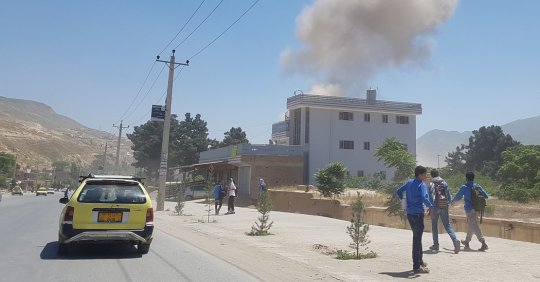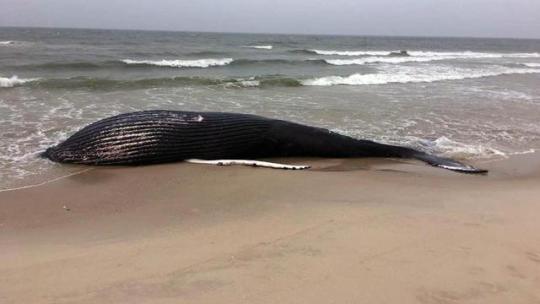Photo

New Post has been published on https://toldnews.com/world/guaido-maduro-does-not-have-full-military-support/
Guaidó: 'Maduro does not have full military support'

Self-declared interim president Juan Guaidó failed in a third attempt to oust Nicolás Maduro. What now?
0 notes
Photo

New Post has been published on https://toldnews.com/world/united-states-of-america/to-stand-out-the-army-picks-a-new-uniform-with-a-world-war-ii-look/
To Stand Out, the Army Picks a New Uniform With a World War II Look

The United States Army wanted a spiffy new service uniform, one that would stand out in a tough recruiting environment and polish the Army’s image after a generation of grinding and divisive wars.
So it turned the clock back. Way back.
It chose a new uniform that looks almost exactly like the old green gabardine wool field coat and khaki trousers that officers wore in World War II. Probably not by coincidence, that’s what the Army was wearing the last time the nation celebrated total victory in a major war.
“We went back and asked, when is the most prominent time when the Army’s service to our nation was universally recognized, and the answer came very quickly,” said Daniel A. Dailey, the sergeant major of the Army, the highest-ranking enlisted soldier in the service. “That victory, that impact on the nation, is still felt today by the sons and daughters and grandsons and granddaughters of the ‘Greatest Generation.’”
The troops who beat the Axis powers in the 1940s gave the service uniform, with its slightly rose-hued trousers or skirt and distinctive belted olive coat, an affectionate nickname: “pinks and greens.” This time around, the Army has decided to just call them Army Greens.
At a White House event for veterans in April, President Trump praised the style.
“Those beautiful new uniforms with the belt — it was a big deal, the belt,” he said. “And if you think those uniforms were inexpensive, they were very expensive. They were very. But they wanted it, and we got it.”
Army Greens will be the military equivalent of a business suit, which the Army largely stopped using during the wars in Iraq and Afghanistan. Just as civilians have been dressing more casually in professional and social settings, troops have been wearing camouflage fatigues in situations that used to call for a jacket and tie, like office work or travel between bases. Even in the Pentagon, officers spend a good deal of their time in combat boots.
With far fewer troops deployed in combat operations now, though, the Army has signaled that it wants to get back to the old spit and polish. It is hoping that reintroducing an iconic service uniform from the days of the Band of Brothers and Rosie the Riveter will help reframe its public image.
The new service uniform is currently in field tests with a few military bands, recruiting battalions and other highly visible troops. With Sergeant Major Dailey overseeing the process, the Army plans to roll out the new uniforms to all soldiers starting in 2020. Soldiers will even be given the option to buy a retro-styled leather bomber jacket to go with the uniform.
The Army says that while the new service uniform will cost more than past models to make, it will also last longer, making it cost-neutral overall.
In recent years, when the Army has wanted to look sharp, troops have been wearing blue. The current dress uniform (which will be retained for ceremonial use) includes a dark blue coat with light blue trousers or skirt — colors chosen to evoke the Continentals who fought under George Washington and the Union Army of the Civil War.
If that uniform has not caught your eye, it may be because Army Blues can be hard to distinguish, not just from similar Navy and Air Force uniforms, but also from a sea of blue-clad civilians: police officers, firefighters, commercial pilots, even doormen, said Kenneth O. Preston, who served as Sergeant Major of the Army from 2004 to 2011.
“People think you’re a cop,” Mr. Preston said. “They are always stopping you and asking you for directions.”
As it happens, that is the same problem that had originally prompted the Army to retire the pinks and greens. After the war ended in 1945, millions of demobilized troops gave away the olive drab uniforms they no longer needed, and heaps more were sold by the Army as surplus. Before long, they were everywhere in civilian life, and had become drab in every sense of the word.
Durable and dirt cheap, they became the de facto uniform for field hands, road gangs and trash collectors. An Army major named A.M. Kamp Jr. lamented in the 1954 edition of the Defense Department’s Quartermaster Review that they could be widely seen on prisoners, drunks and “any tramp or derelict who at once adopted the new clothing as his Sunday best.”
“The soldier, being constantly confronted with the debauchment of his uniform,” Major Kamp wrote, “soon loses his pride in wearing it.”
So that year, the Army began issuing a sleek, modern-looking gray-green polyester-blend service uniform, based on 1950s business suits. Both officers and enlisted soldiers wore that service uniform for the next half-century, until the style was phased out in 2007.
“That 1950s was my favorite uniform, very modern, very smart, very American,” said Bruce Bassett-Powell, a historian of military dress and a British Army veteran who now lives in Texas. “But it’s too tied up in associations with Vietnam. And it became the prototype for the uniform of nearly every dictator in South America and Asia. So I suppose it’s best to move on.”
Trying to ride the triumphant coattails of past generations through military dress is hardly new. Mr. Bassett-Powell noted that when Napoleon III of France declared war on Prussia in 1870, he dressed his soldiers to look like the army that his much more famous uncle, Napoleon Bonaparte, had led decades before to conquer much of Europe. The nephew’s war didn’t turn out so well — he was defeated and captured at Sedan, and his imperial regime collapsed.
“Sometimes these throwbacks can boomerang on you,” Mr. Bassett-Powell said.
Redesigning a uniform is not as straightforward a task as it may seem, said Jennifer Craik, a professor of fashion at Queensland University of Technology in Australia.
Change the uniform too much, and you risk losing the continuity, legitimacy and authority communicated by an Army’s traditional design. “Plastic buttons or a Peter Pan collar simply wouldn’t feel right,” she said.
On the other hand, change the uniform too little, and you risk continuing to blend in with the doormen, the pilots and other fashion usurpers.
“The right uniform immediately exudes trust and power — it’s a shorthand that says, ‘Don’t worry, I know what I’m doing,’” Ms. Craik said. “Imagine the opposite: If you got on a plane and the pilot turned up in jeans and a T-shirt, you might get right off.”
An effective military uniform, she said, has to be distinctive but also immediately recognizable, and the best designs should reflect an institution at its best.
“That’s why I think they decided to go back to the old style,” she said. “World War II is seen as a just war, a good war. This uniform says, ‘We are the good guys.’”
0 notes
Photo

New Post has been published on https://toldnews.com/technology/entertainment/avengers-endgame-muscles-out-competition-to-maintain-box-office-lead/
‘Avengers: Endgame’ Muscles Out Competition to Maintain Box Office Lead

The weekend’s box office totals laid bare the have and have-nots of Hollywood in brutal fashion.
The No. 1 movie in the United States and Canada — as could have been predicted a year ago — was the Disney-Marvel juggernaut “Avengers: Endgame,” which collected roughly $146 million. Total domestic ticket sales for the all-star superhero movie stand at $620 million, according to Comscore. The film has collected a jaw-dropping $2.2 billion globally since arriving in theaters less than two weeks ago.
[Read our review of “Avengers: Endgame.”]
That left three new movies to compete for scraps.
“The Intruder” (Sony) did the best. A thriller directed by Deon Taylor, “The Intruder” took in about $11 million, a respectable debut for a lightly marketed movie that cost just $8 million to make.
Lionsgate, which has been experiencing a box office drought, tried to compete with “Long Shot,” an R-rated comedy starring Seth Rogen and Charlize Theron. Despite strong reviews, the movie lived up to its title, selling about $10 million in tickets. “Long Shot” cost roughly $40 million to make and another $30 million to market. Lionsgate said on Sunday that it expected “Long Shot” to find a broader audience over the next month, with the Mother’s Day and Memorial Day weekends holding promise.
The studio is one of a handful of smaller ones that have been struggling as streaming services have moved aggressively into their territory — midbudget action-adventures, comedies and dramas. Lionsgate had held up “Long Shot” to Wall Street as one of a handful of movies that would signify a turnaround for its film division. (Another was “Hellboy,” which bombed last month.) The studio will try again with “John Wick: Chapter 3 — Parabellum,” which arrives in theaters on May 17.
Another small studio, STXfilms, had an even gloomier weekend. In partnership with Alibaba Pictures, it rolled out “UglyDolls” — hyped before its release as the start of a franchise — to disappointing ticket sales of about $8.5 million. The poorly reviewed film, directed by Kelly Asbury and based on a line of plush toys, cost at least $45 million to make and $30 million to market.
STXfilms had lined up more than 100 promotional partners, including McDonald’s and Walmart, to generate interest in “UglyDolls,” an animated musical featuring the voices of stars like Kelly Clarkson, Pitbull and Joe Jonas.
STXfilms and Alibaba hope the film will perform better in China, where it is expected to be released this summer. An “UglyDolls” series is also in the works for Hulu.
#entertainment news kannada#entertainment news story ideas#entertainment news us weekly#entertainment t news#entertainmentcenter#top 5 entertainment news
0 notes
Photo

New Post has been published on https://toldnews.com/world/gaza-conflict-death-toll-mounts-amid-weekend-violence/
Gaza conflict: Death toll mounts amid weekend violence

Media playback is unsupported on your device
Media captionRockets were seen in the sky above Ashkelon in Israel
The death toll is mounting on both sides after a weekend of cross-border violence between Israel and militants on the Gaza strip.
The most intense clashes in years have so far left at least four Israelis and 23 Palestinians dead.
The Israeli army says more than 600 rockets have been fired into Israeli territory since Saturday. They say more than 150 have been intercepted.
Parts of the international community, including the UN, have called for calm.
Reports on Sunday night suggest the UN, Qatar and Egypt are trying to broker a ceasefire.
Palestinian territories profile
The Israeli military say they have hit 320 targets so far this weekend.
On Sunday, Israeli Prime Minister Benjamin Netanyahu said he had ordered the military to “continue its massive strikes on terror elements” in Gaza.
Israeli forces around the strip would be “stepped up with tank, artillery and infantry forces”, he added.
As rockets continue to fall in Israel, all schools within 40km (25 miles) of the Gaza strip have been closed and some shelters have opened to the public.
What do we know about casualties?
Four people have so far died from the violence in Israel:
A 58-year-old died from injuries in a rocket strike on a house in Ashkelon on Saturday night
Another died in Ashkelon on Sunday when a rocket hit a factory
Another man, 67, was killed when his car was apparently struck by an anti-tank missile
A fourth, who was in his early 20s, was killed in the southern city of Ashdod
Image copyright
EPA
Image caption
The funeral for one Israeli casualty, Moshe Agadi, was held on Sunday
The Gaza Health Ministry says 23 Palestinians have died across the weekend. Most of the deaths came on Sunday. The Islamic Jihad group said seven of the dead were its members.
Civilians, including a 12-year-old boy and two pregnant women were also among those reportedly killed.
Israel has contested the account of the death of one woman and her 14-month-old niece on Saturday. They blamed their deaths on a Palestinian rocket that fell short of its target.
On Sunday, the Israeli military admitted a targeted assassination of a Hamas commander named Hamed Hamdan al-Khodari – sharing a video of the apparent moment they hit his car.
The sites Israel says has destroyed include a multi-storey building in Gaza City, which it said included Hamas intelligence offices.
Turkey said its state news agency Anadolu had an office there. Foreign Minister Mevlut Cavusoglu called Israeli strikes on civilians “a crime against humanity”.
On Sunday night, Hamas leader Ismail Haniya said in a statement that “returning to a state of calm is possible” if Israel committed to a “complete ceasefire”.
Image copyright
AFP
Image caption
A car, apparently belonging to Hamas militant, was one of the sites targeted by Israel on Sunday
How did the latest violence develop?
It began on Friday, during protests in Gaza against the blockade of the area – which Israel says is needed to stop weapons reaching militants.
A Palestinian gunman shot and wounded two Israeli soldiers at the boundary fence. Israel retaliated with an air strike that killed two militants.
The rocket barrage from Gaza began on Saturday morning. Israel’s Iron Dome missile defence system shot down dozens of the rockets, but a number of homes in Israeli towns and villages were hit.
How does the flare-up in violence compare?
It is the one of the most surges in violence since the conflict of July and August 2014.
In that year, Israel launched a ground offensive on Gaza following the kidnapping and killing of three Israeli teenagers.
The conflict resulted in the death of 67 Israeli soldiers. Hamas and its allies launched more than 4,500 rocket strikes that killed six civilians in Israel.
On the Palestinian side, 2,251 people, including 1,462 civilians, were killed in the seven-week conflict, according to the UN.
Since then, Palestinian militants have continued to carry out sporadic strikes on Israel.
Image copyright
Reuters
Image caption
People are seen crouching amid a siren warning in the Israeli city of Ashkelon
In a previous wave this year, in March, several rockets were fired into southern Israel, triggering raids on Gaza by the Israeli air force. No fatalities were reported on either side.
In early April a ceasefire was brokered by Egypt, but Hamas and allied militant groups later accused Israel of violating its terms.
What has the reaction been?
Nickolay Mladenov, the UN Special Coordinator for the Middle East Peace Process, has condemned the recent violence and said the UN is working with both sides to calm the violence.
Skip Twitter post by @nmladenov
I condemn the continuing launching of rockets from #Gaza. Enough #Palestinian and #Israeli lives have been lost, people injured, houses damaged and destroyed! It is time to de-escalate and return to the understandings of the past few months before it is too late. #UN
— Nickolay E. MLADENOV (@nmladenov) May 5, 2019
End of Twitter post by @nmladenov
In a statement, UN Chief Antonio Guterres has condemned “in the strongest terms” rockets being launched into Israel.
“He urges all parties to exercise maximum restraint, immediately de-escalate and return to the understandings of the past few months,” the statement added.
Speaking on Fox News on Sunday, US Secretary of State Mike Pompeo said Israelis have “every right to defend themselves” from rocket attacks.
“I hope we can return to the ceasefire that had been in place for weeks and had been holding significantly before this,” he added.
The European Union on Sunday called for rocket fire to “stop immediately”.
Iran’s foreign minister, condemned what he labelled as Israel’s “savage” attacks on Gaza, while also hitting out at “unlimited American support” of Israel.
Save the Children has said it has had to suspend all but essential programs in the Gaza strip.
Jeremy Stoner, their Middle East Regional Director, said the group were “deeply alarmed” by rapidly rising casualties on both sides, and called for de-escalation.
http://platform.twitter.com/widgets.js
0 notes
Photo

New Post has been published on https://toldnews.com/world/united-states-of-america/miss-america-miss-teen-usa-and-miss-usa-are-all-black-women-for-the-first-time/
Miss America, Miss Teen USA and Miss USA Are All Black Women for the First Time

Despite a long history of segregation and racism, America’s top pageants have broken racial barriers in recent decades. Vanessa Williams became the first black woman to win the Miss America title in 1984. Carole Gist won Miss USA in 1990. Janel Bishop won Miss Teen USA in 1991.
Each competition has had multiple black winners since.
Last week, for the first time, black women wore the crowns of all three major pageants simultaneously.
Cheslie Kryst, 28, won the Miss USA contest, and Kaliegh Garris, 18, won Miss Teen USA. They joined Nia Franklin, 25, who was crowned as the 2019 Miss America in September.
The three wins have become a powerful symbol of how much American views on beauty have evolved from a past marred by racism and gender stereotypes, even as black women leaders are still severely underrepresented in other fields, like corporate America or in Congress.
“It is important to little brown and black girls to see three strong figures, three strong women, African-American women that are doing so much great work,” Ms. Franklin said on Saturday. “People will argue that race doesn’t matter. But race does matter in America, because of the history, because of slavery.”
News of the pageant wins resonated with many on Saturday, drawing words of support from the actress Halle Berry and Senator Kamala Harris, who is vying for the 2020 Democratic Party presidential nomination, among other influential figures.
“Nia, Cheslie, and Kaliegh: you are trailblazers, creating your own path on your own terms,” Ms. Harris said on Twitter.
The attention comes as the country increasingly rethinks long-held gender norms, spurred on by the #MeToo movement. Pageants have recently sought to put more emphasis on the offstage lives of the women and girls, highlighting their accomplishments and charity work, instead of only their appearances.
The Miss Universe Organization, which runs Miss USA and Miss Teen USA, began allowing transgender women to participate in 2012. Last year, the Miss America Organization announced it would end the swimsuit contest, among other changes.
It’s the racial history of pageants that the “trifecta of black winners” perhaps highlights the most, said Ashley Nkadi, a former Miss Black Ohio who has written about the pageants’ past.
“I think the image of it is very important, especially knowing where mainstream pageantry has come from,” she said.
Black women have long been underrepresented in the contests, said Elwood Watson, a professor of history and African-American studies at East Tennessee State University. For decades, they were barred from Miss America contests.
“They have always been seen as ‘the other,’ and white women have always been the standard of beauty,” he said.
The 1968 Miss America pageant held in Atlantic City is one of the most infamous examples of that dynamic. The competition was held as a fight for civil rights raged across the country; only white women were in the pageant.
On the boardwalk outside, feminists threw bras, curling irons and false eyelashes into a trash can to condemn the scrutiny of women’s bodies by male judges.
Four blocks away, in a Ritz-Carlton hotel, another ceremony was held, crowning 19-year-old Saundra Williams as the first ever Miss Black America, in protest of the “white stereotype,” The New York Times reported.
“Miss America does not represent us because there has never been a black girl in the pageant,” she said. “With my title, I can show black women that they too are beautiful.”
There have been a number of milestones since then. As the 1970 Miss Iowa, Cheryl Browne became the first black contestant to compete in the Miss America contest. Ms. Franklin said she is the ninth black Miss America.
The 2019 winners are not strangers to racism. Ms. Franklin recalled that when she was 9, she was called a racial slur and told to go back to Africa. Ms. Kryst said she has been told that she was “pretty for a black girl.”
“Of course there are going to be parts of me that have experienced racism,” Ms. Franklin said. “It hasn’t stopped me. I have come through this Miss America system with strength and pride and grace.”
But Ms. Nkadi said more representation is needed. Pageant winners typically are not “plus-size” or do not have darker skin, she said.
“I definitely still think the Eurocentric beauty model still dominates,” she said.
Diversity in pageantry hasn’t reached many groups, said Hilary Levey Friedman, a visiting professor of education at Brown University, who has studied pageants. Ms. Friedman said Latina and Asian women have struggled to be represented.
“Increasing the diversity overall is definitely a conversation to be had,” she said.
http://platform.twitter.com/widgets.js
#northwestern u us news#ThursdayMorning#us news university rankings#usa news govt shutdown#usa news highlights#usa news ratings
0 notes
Photo

New Post has been published on https://toldnews.com/world/asia-pacific/taliban-kill-unarmed-afghan-police-officers-waiting-for-pay/
Taliban Kill Unarmed Afghan Police Officers Waiting for Pay

KABUL, Afghanistan — Unarmed police officers were lining up for their monthly pay in northern Afghanistan on Sunday when a Taliban suicide bomber blew up an explosives-laden Humvee next to a police compound, setting off a six-hour siege.
At least seven Taliban gunmen wearing police uniforms — some armed with suicide vests — rushed through a hole blown open by the explosion, police officials said. When the siege was eventually quelled, 20 police officers had been killed and 35 wounded, the officials said. Twenty civilians were also hurt, according to the Interior Ministry in Kabul.
By nightfall, police commanders said they had killed all attackers in the police headquarters in Pul-i-Kumri, the capital of Baghlan Province, about 150 miles north of Kabul. Bismullah Attash, a member of the Baghlan provincial council, said two of the uniformed attackers drove into the compound in private vehicles.
Abdul Qayoum Mubariz, a police officer based at the headquarters, said about 25 police officers — almost all of them unarmed — were waiting in line at a bank in the compound when the Humvee exploded. He said several soldiers were carrying plates of food from a dining hall as the attackers stormed inside.
“We heard a strong explosion,” Officer Mubariz said. “I got confused for a few seconds and then escaped to an office to hide.”
Among those killed was Hasibullah Amiri, commander of a 300-strong police battalion in the Baghlan district of Dahana-i-Ghori, said Asadullah Shahbaz, another provincial council member. Police officers and commanders travel from districts outside the provincial capital to collect their monthly pay.
Civilian employees of the police department also visit the headquarters to undergo biometric scans for identification, Mr. Shabaz said, and people seeking passports go there, as well. An official at the local hospital, who asked not to be identified because he was not authorized to speak to reporters, said eight women and four children were among those treated for injuries from the attack.
A Taliban spokesman, Zabihullah Mujahid, claimed responsibility, but said there had been five, not eight, “heavily armed martyrdom seekers.”
It was the latest in a series of brazen Taliban attacks on Afghan police and army compounds in recent months. Both sides in the war, now in its 18th year, have increased operations as they seek leverage in continuing peace talks between the United States and the Taliban in Doha, Qatar.
The attack in Baghlan came after a proposal on Friday by the Afghan president, Ashraf Ghani, for a cease-fire during the holy month of Ramadan, which begins this week. The Taliban rejected the offer.
Sunday’s incursion was particularly deadly because national police officers are generally forbidden to carry weapons while off duty, in this case leaving most of them defenseless as they waited to be paid.
“The enemy is aware what is a good time to attack,” said Bismillah Attash, a provincial council member. He added that several officers on duty in the compound had been armed with pistols, but were not able to fire effectively.
Several previous attacks on Afghan military bases have also involved Taliban fighters dressed in police or army uniforms and using vehicles captured from or abandoned by Afghan security forces. The insurgents typically pack the vehicles with explosives and ram them into base gates or walls.
Sunday’s incursion was similar to a Taliban attack in the eastern city of Jalalabad in 2011, in which seven bombers in army uniforms and suicide vests killed 18 people and wounded 70 as police officers and soldiers waited at a bank to for their monthly pay.
#asia news 2019#asia news finance#asia news islamabad#asia news wikipedia#asia news yesterday#asianet news tv
0 notes
Photo

New Post has been published on https://toldnews.com/technology/entertainment/review-can-this-marriage-be-saved-at-the-local-pub/
Review: Can This Marriage Be Saved (at the Local Pub)?

“State of the Union,” a TV series in 10-minute servings, offers Rosamund Pike and Chris O’Dowd as a couple who self-therapize over white wine and ale.
#entertainment news feed#entertainment news of today#entertainment news script sample#entertainment news uganda#entertainment news vanguard#entertainment news youtube channels
0 notes
Photo

New Post has been published on https://toldnews.com/world/united-states-of-america/37-foot-whale-washes-up-in-the-hamptons-rescuers/
37-Foot Whale Washes Up in the Hamptons: Rescuers

A 37-foot humpback whale washed ashore in Westhampton on Sunday morning, an animal rescue group said.
It was the first large animal to strand in New York this year, the Atlantic Marine Conservation Society said.
The dead female whale was found in Cupsoge County Park. The whale would remain in place for at least a day while the group coordinated heavy equipment to move it, said spokesperson Rachel Bosworth.
!function(f,b,e,v,n,t,s)if(f.fbq)return;n=f.fbq=function()n.callMethod?
n.callMethod.apply(n,arguments):n.queue.push(arguments);if(!f._fbq)f._fbq=n;
n.push=n;n.loaded=!0;n.version=’2.0′;n.queue=[];t=b.createElement(e);t.async=!0;
t.src=v;s=b.getElementsByTagName(e)[0];s.parentNode.insertBefore(t,s)(window,
document,’script’,’//connect.facebook.net/en_US/fbevents.js’);
fbq(‘init’, ‘505866882913758’);
fbq(‘track’, “ViewContent”);
fbq(‘track’, ‘PageView’);
var api_key = “78a56d51e7afc43291c00e9e6f73e0ad”;
window.fbAsyncInit = function()
FB.init(
appId : ‘api_key’, // App ID
version : ‘v2.6’,
channelUrl : ‘//www.nbcnewyork.com/templates/channel.html’, // Channel File
status : true, // check login status
cookie : true, // enable cookies to allow the server to access the session
xfbml : true // parse XFBML
);
// Additional initialization code here
;
// Load the SDK Asynchronously
(function(d)
var js, id = ‘facebook-jssdk’, ref = d.getElementsByTagName(‘script’)[0];
if (d.getElementById(id)) return;
js = d.createElement(‘script’); js.id = id; js.async = true;
js.src = “http://connect.facebook.net/en_US/sdk.js”;
ref.parentNode.insertBefore(js, ref);
(document));
#Breaking news#Brooklyn#Connecticut#e commerce usa news#local news#long island#manhattan#New Jersey#new york city news#new york news#nj#ny#nyc#Queens#staten island#the bronx#us news 2018 college rankings#usa news f 16#usa news for india#usa news today sports#usa zinsen news
0 notes
Photo

New Post has been published on https://toldnews.com/technology/entertainment/nikila-sri-kumar-michael-mekeel/
Nikila Sri-Kumar, Michael Mekeel

Nikila Susheela Sri-Kumar and Michael Leonidas Mekeel were married May 4 at the Paramour Estate in Los Angeles. Sajjan Sri-Kumar, the brother of the bride who was ordained through the Universal Life Church, led a ceremony that incorporated Hindu and Quaker wedding traditions.
The couple met at Yale, from which they graduated, the groom magna cum laude.
Ms. Sri-Kumar, 29, is a group product manager in New York for Affirm, a financial technology company.
She is the daughter of Nalini Sri-Kumar and Komal Sri-Kumar of Los Angeles. The bride’s father owns a macroeconomic consulting firm, which bears his name, in Santa Monica, Calif. Her mother retired as a partner in McKinsey & Company in Los Angeles.
Mr. Mekeel, 30, is an analyst and investment professional at EMC, a hedge fund in New York. He received an M.B.A. from Harvard.
He is the son of Frances Offenhauser and Michael Mekeel of Los Angeles. The groom’s parents are owners and founders of an architecture firm in Los Angeles that bears their names.
#entertainment news brad pitt#entertainment news for the week#entertainment news last week#entertainment news oscars#entertainment news photos#ktla 5 news entertainment
0 notes
Photo

New Post has been published on https://toldnews.com/world/united-states-of-america/mexico-declares-victory-over-fuel-thieves-but-is-it-lasting/
Mexico Declares Victory Over Fuel Thieves. But Is It Lasting?

IRAPUATO, Mexico — Soon after taking office in December, President Andrés Manuel López Obrador declared war on fuel theft, an enduring scourge that had been costing the nation billions of dollars a year.
Thieves had launched a particularly damaging attack, draining 1.5 million gallons of gasoline through a single illegal tap over 10 hours and immediately elevating the issue to the top of the administration’s agenda. But targeting the fuel theft racket as his first major security initiative also appeared to be an astute political move by Mr. López Obrador.
Brought to power on a wave of populist anger that handed him a mandate to reshape the nation, Mr. López Obrador was eager to make good on his core promises: to tackle corruption and crime, and to reduce poverty and inequality by making the country’s sources of wealth work for all.
But he inherited, on Dec. 1, a lackluster economy and an unenviable security situation. Mexico was approaching the end of its deadliest year on record, with the criminal world more fragmented and complicated than ever, enabled in part by chronic government corruption.
Tackling fuel theft gave him a way to demonstrate action on several fronts at once. Criminal organizations, sometimes in collaboration with corrupt workers from the state-run oil company, Pemex, were siphoning gasoline and diesel fuel from pipelines and from within refineries and storage installations. The crime cost the federal government more than $3 billion last year alone, impeding efforts to resuscitate Pemex.
“By choosing fuel theft he gets a claim on fighting corruption and insecurity and can do stuff on energy that previous governments failed to do, helping Pemex to become the giant of yesteryear,” said Dwight Dyer, a risk consultant and former official in Mexico’s energy ministry. “So, it all sells very well politically.”
But while there are early indications the government made strides and scored points with voters, there seems to be little faith beyond the López Obrador administration that these gains will hold. It is a doubt fed by a chronic lack of confidence in the Mexican government’s ability — or willingness — to bring the nation’s increasingly sophisticated criminal groups to their knees.
The effort to curb fuel theft began in late December, when Alfonso Durazo, Mexico’s security minister, deployed federal security forces to guard frequently attacked stretches of pipeline and Pemex installations where corrupt employees were suspected of abetting the fuel mafias.
Suspected thieves and their collaborators were arrested, bank accounts were frozen and property was seized.
Investigators discovered that the pipeline system was “full” of clandestine taps, the minister said in an interview. “We kept finding things and finding things,” he recalled.
The government even shut down the most heavily targeted pipelines, which caused shortages and long lines at service stations. Despite the disruption, the population remained overwhelmingly supportive of Mr. López Obrador — particularly after a punctured pipeline exploded in January in an impoverished area, killing more than 130 people who had gathered in hopes of getting free gasoline.
Less than four months after beginning the offensive, Mr. López Obrador said his administration had reduced fuel theft by 95 percent, and declared victory: “We managed to defeat the fuel thieves.”
Pemex reported that fuel theft fell to an average of 168,000 gallons per day in April, down from more than 3.4 million gallons when the president took office, generating savings of more than $600 million.
But many suspect the sharp and sudden decrease in fuel theft is temporary, and that the thieves are just biding their time until the government’s attention has shifted elsewhere.
“It has stopped for now,” said Roberto González, the vicar in a working-class Catholic parish in Irapuato, a central Mexican city where fuel theft was rampant until the federal crackdown. “But they’re waiting for the moment to start again.”
Fuel theft, known colloquially as “huachicoleo,” is a longstanding problem that had gotten dramatically worse in recent years as the enterprise shifted from being the domain of local gangs and entrepreneurs to a major industry dominated by the nation’s largest and most-organized criminal groups.
In the first 10 months of 2018, officials said, the authorities discovered more than 12,500 illegal taps on the nation’s pipelines. By November, thieves were stealing more than 3.4 million gallons a day. A decade ago, by comparison, thieves drilled only about 460 illegal taps, stealing fewer than 126,000 gallons a day.
The impact has been particularly profound for Irapuato and for its home state, Guanajuato, a center of Mexico’s automobile manufacturing industry.
In recent years the region has seen a sharp increase in violence, much of it related to the battle between criminal organizations for control of the stolen-fuel trade, officials say.
More than 2,600 intentional homicides were reported last year in Guanajuato, up from about 1,100 in 2017, according to government statistics.
Irapuato had been “very peaceful” until last year, its municipal president, Ricardo Ortiz Gutiérrez, said in an interview. But the bloodshed began in earnest during the first week of 2018.
The surge in violence landed Irapuato in sixth place on a list of the world’s most dangerous cities with more than 300,000 residents, according to the Citizens’ Council for Public Security and Criminal Justice, a nongovernmental group in Mexico.
The reaction from the criminal groups to the government offensive was immediate and robust.
In Guanajuato, they blockaded roads with burning vehicles to impede the movement of government security forces. A bomb was planted in a truck parked outside a major refinery in the city of Salamanca. The Santa Rosa de Lima Cartel, a local criminal group specializing in oil theft, issued a death threat against Mr. López Obrador, officials said.
And in March, unidentified gunmen opened fire on the local office of the federal attorney general in Irapuato after the arrest of suspected members of the Santa Rosa de Lima Cartel, local news media reported.
“They are very cruel, very cruel,” said Mr. Ortiz Gutiérrez, the municipal president.
Many observers — here in the state of Guanajuato and elsewhere — believe that the fuel thieves will come back once the government establishes new security priorities and shifts its forces elsewhere.
“Organized crime is just waiting it out,” said Gonzalo Monroy, an energy consultant based in Mexico City.
Part of the challenge for the government will be to dissolve the local support that the fuel thieves have cultivated. Residents in some communities have found employment with the gangs and many more have been happy to pay the cut-rate prices for black-market fuel, which was often sold openly on the shoulders of highways and from the backs of trucks.
The gangs would shore up that support by handing out gifts to townspeople on special occasions, distributing food and paying for medical care and other community services.
“They threw big parties,” said Father González, the vicar of a parish in Aldama, a working-class neighborhood here where, until recently, fuel thieves operated openly.
The president has announced a plan to begin special social development programs in regions where fuel theft has flourished. And Mr. Durazo insists that he intends to keep up the pressure until the crime abates.
“The deployment isn’t going to end,” the security secretary vowed. “It’s totally sustainable, and we are going to sustain it for however long it’s necessary.”
#usa news about india#usa news donald trump#usa news group#usa news network#usa today news quiz#wusa news opens
0 notes
Photo

New Post has been published on https://toldnews.com/world/brunei-says-it-wont-enforce-death-penalty-for-gay-sex/
Brunei says it won't enforce death penalty for gay sex
Image copyright
Reuters
Image caption
The speech is the first time Brunei’s ruler has responded to global pressure over the new laws
Brunei has backtracked on laws introduced last month that would have made sex between men and adultery punishable by stoning to death.
Sultan Hassanal Bolkiah on Sunday extended a moratorium on the death penalty to the new legislation.
The reversal follows global outcry over the laws, including boycotts and celebrity protests.
While permitted for some crimes, no executions have been carried out in Brunei since 1957.
Last month Brunei rolled out a strict new interpretation of Islamic laws, or Sharia.
In a speech, the sultan said he was aware there had been “many questions and misperceptions” regarding the implementation of the legislation, called Syariah Penal Code Order (SPCO).
Brunei: What you need to know
The woman who decides if men can take a second wife
While saying that a moratorium on the death penalty would be applied to the SPCO he also defended the new rules, saying their “merit” would become clear.
The speech marks the first time the country’s ruler has spoken publicly about the legislation since their introduction.
Homosexuality was already illegal in Brunei and punishable by up to 10 years in prison.
Muslims make up about two-thirds of the country’s population of 420,000.
What are the laws?
The small South-East Asian nation first introduced Sharia law in 2014, giving it a dual legal system with both Sharia and Common Law.
The first phase covered crimes punishable by prison sentences and fines.
Media playback is unsupported on your device
Media caption“As a kid… we were taught the stones should not be too big”
The laws introduced on 3 April marked the next phase of the legislation, and covered crimes punishable by amputation and stoning.
Under the legislation:
Offences such as rape, adultery, sodomy, robbery and insult or defamation of the Prophet Muhammad carry the maximum penalty of death
Lesbian sex carries a different penalty of 40 strokes of the cane and/or a maximum of 10 years in jail
The punishment for theft is amputation
Those who “persuade, tell or encourage” Muslim children under the age of 18 “to accept the teachings of religions other than Islam” are liable to a fine or jail
Individuals who have not reached puberty but are convicted of certain offences may be instead subjected to whipping.
What was the reaction?
The laws sparked international outrage, throwing the tiny South-East Asian nation into the global spotlight.
Ahead of their implementation, the UN warned that the laws contravened international human rights standards set out in the 1948 Universal Declaration of Human Rights – which was ratified by Brunei in 2006.
Celebrities including George Clooney and Elton John called for a boycott of luxury hotels with links to Brunei over the legislation.
Mr Clooney said the new laws amounted to “human rights violations”.
Many in Brunei’s gay community expressed shock and fear at the punishments.
0 notes
Photo

New Post has been published on https://toldnews.com/world/asia-pacific/cyclone-fani-hits-bangladesh-killing-5-evacuations-prevent-more-casualties/
Cyclone Fani Hits Bangladesh, Killing 5; Evacuations Prevent More Casualties

DHAKA, Bangladesh — The most powerful storm to hit Bangladesh in years tore into the country over the weekend, uprooting trees, destroying thousands of homes and killing five people, but spared this crowded nation from worse damage.
G.M. Abdul Quader, the joint secretary of Bangladesh’s Ministry of Disaster Management and Relief, said the authorities had prepared aggressively for the storm, Cyclone Fani, which barreled up the Bay of Bengal with wind speeds of 120 miles per hour.
As in neighboring India, where the storm made landfall on Friday before heading northeast, in Bangladesh thousands of volunteers had woven through villages with megaphones, warning people about the impending storm’s dangers and urging them to move to shelters. Both countries also sent extensive text messages to the tens of millions of people in the cyclone’s path.
“We were all working day and night,” Mr. Quader said. “We had little chance to go home and sleep.”
By Sunday evening, the storm — categorized as “extremely severe” when it struck the Indian coast — had weakened. Of the more than 1.6 million people in Bangladesh who were evacuated, Mr. Quader said all had returned home.
Though devastating for many farming communities, the damage was still remarkably low. Just 20 years ago, thousands of people were killed when a cyclone of similar size struck Odisha, a poor coastal Indian state that also bore the brunt of Cyclone Fani.
Since then, the authorities in India and Bangladesh, which is geographically especially prone to storms, have prepared for such natural disasters by drafting meticulous evacuation plans and building hundreds of shelters.
Apart from the five fatalities in Bangladesh, several hundred people were injured. Part of a dam crumbled in the remote coastal district of Patuakhali, flooding villages, killing cattle and destroying wells and thousands of acres of crops. On local television channels, families picked through tin shacks obliterated by the wind and rain.
Indian officials in Odisha were busy over the weekend clearing debris with power saws and trying to restore full electricity to the state. Bishnupada Sethi, the special relief commissioner, said 34 people had been killed in India, probably all by falling trees.
Still, for such a heavily populated strip of coastline, Mr. Quader said the toll could have been much worse. “Allah was merciful to us,” he said. “Our losses and damages were little compared with our apprehension.”
#asia good news#asia news dalit#asia news january 2019#asia news network live#asia news weekly#asia vision news
0 notes
Photo

New Post has been published on https://toldnews.com/technology/facebook-opens-a-command-post-to-thwart-election-meddling-in-europe/
Facebook Opens a Command Post to Thwart Election Meddling in Europe

DUBLIN — Inside a large room in Facebook’s European headquarters in Ireland’s capital, about 40 employees sit at rows of desks, many with two computer screens and a sign representing a country in the European Union.
Large screens at the front display charts and other information about trends on the social network’s services, including Instagram and the messaging app WhatsApp. In the back, muted televisions broadcast BBC and other European news stations.
The cramped space is home to Facebook’s newly opened operations center to oversee the European Union’s parliamentary election, which will be held May 23 to May 26 in 28 countries.
Modeled after the “war room” that the Silicon Valley company created before last year’s midterm elections in the United States, the people inside are tasked with washing Facebook of misinformation, fake accounts and foreign meddling that could sway European voters. A similar command post was set up in Singapore for elections in India.
Eager to show it is taking threats seriously as it faces pressure from governments across Europe to protect the integrity of the election, Facebook invited about two dozen journalists to visit its hub last week.
“We are fundamentally dealing with a security challenge,” said Nathaniel Gleicher, Facebook’s head of cybersecurity policy. “There are a set of actors that want to manipulate public debate.”
The social network has good reason to be proactive after Russians used the platform to influence American voters in the 2016 presidential election. The company has since taken down several networks of accounts linked to foreign-influence campaigns, including some targeting users in Europe.
The European election will determine who controls the European Parliament and sets the agenda of the European Union for the next five years. It will influence how the region grapples with issues like Britain’s exit from the European Union, immigration, income inequality and the rise of extremist ideologies. European leaders have warned that foreign groups will use social media to manipulate public opinion.
Facebook is becoming more aggressive in regulating content after initially trying to avoid entanglement in free speech issues. Last week, it barred the conspiracy theorist Alex Jones and several other divisive figures from its platforms.
The company is also under pressure from regulators. European leaders are considering new policies to force tech giants to rid their platforms of misinformation, hate speech and extremist content. Facebook faces several investigations related to its handling of user data.
The election center in Dublin will be open through this month’s vote. Data analysts, content moderators, engineers and attorneys from across Facebook were flown in from around the world. All 24 of the European Union’s official languages are represented.
Inside the room, employees — many in jeans, T-shirts and hoodies — appeared to be mostly in their 20s or 30s. Many seemed to be browsing news articles from the country they were overseeing.
It’s hard to know what effect their work may have beyond public relations. Facebook allowed journalists to observe for only a few minutes. Citing security concerns, the company didn’t allow employee interviews, and it limited what could be photographed.
Facebook also wouldn’t say what actions the European team had taken since the center opened last week, other than it had reviewed “hundreds” of pieces of material. The team is alerted to questionable content by an automated system that finds problematic content, or when there’s a surge in the flagging of a piece of content by users, said Lexi Sturdy, a public policy manager brought to Dublin from Facebook’s headquarters in Menlo Park, Calif., to oversee the effort.
Depending on the language or the country where the post, video or photo originated, a team member reviews the material and decides whether to recommend that it be taken down. The ultimate decision is made by an employee who decides if the content meets the company’s user guidelines. In some instances, what’s flagged will lead to a bulk takedown of posts and accounts.
But even as Facebook outlined how ready it was, the platform remains vulnerable. Researchers recently highlighted the use of WhatsApp to spread misinformation ahead of elections in Spain last week. Another persistent problem is material about news events or politics that don’t technically violate Facebook’s policies but is used by far-right and other groups to exaggerate divisions in countries.
And as Facebook clamps down on certain forms of bad behavior, like the use of fake accounts, new methods always emerge.
The goal over time, Mr. Gleicher said, is to “make the platform much more resistant to the kind of manipulation they are trying to use.”
#3m technology news#channel 4 news technology correspondent#l&t technology news#questor technology news#tech news youtube#technology news 2014
0 notes
Photo

New Post has been published on https://toldnews.com/world/united-states-of-america/trump-says-kentucky-derby-ruling-was-not-a-good-one/
Trump Says Kentucky Derby Ruling Was ‘Not a Good One’

President Trump had an opinion about the outcome of the Kentucky Derby and shared it — as he does with so many other opinions — on Twitter on Sunday.
“The Kentucky Derby decision was not a good one,” he tweeted. “It was a rough and tumble race on a wet and sloppy track, actually, a beautiful thing to watch. Only in these days of political correctness could such an overturn occur. The best horse did NOT win the Kentucky Derby – not even close!”
For the first time in the history of the legendary horse race, the horse that crossed the finish line first was disqualified for interference and stripped of its win.
The first-place finisher, Maximum Security, was disqualified because he jumped a puddle on the very wet track and slid to the outside, preventing his rival, War of Will, from moving forward and forcing its rider, Tyler Gaffalione, to squeeze his knees just to stay on his horse.
At the Kentucky Derby on Saturday, racing stewards watched a video for more than 20 minutes before issuing their ruling: Down came Maximum Security and up went Country House, a 65-1 improbable victor.
This was the first time that a foul had invalidated a Kentucky Derby win. Only one other horse has been stripped of its win: In 1968, Dancer’s Image was disqualified after a failed drug test days after the race, leading Forward Pass to be named the winner.
http://platform.twitter.com/widgets.js
#FridayMorning#h&m usa news#us m&a news#us news outlets#usa news volleyball#usa news white house
0 notes
Photo

New Post has been published on https://toldnews.com/technology/entertainment/avengers-endgame-nears-global-record-with-over-2-billion/
'Avengers Endgame' nears global record with over $2 billion

“Avengers: Endgame” continued its global domination at the box office in a second week victory lap that saw the blockbuster cross the $2 billion mark in record time and unseat “Titanic” as the second highest-grossing film ever worldwide. Domestically, newcomers, including thrillers (“The Intruder”), well-reviewed comedies (“Long Shot”) or animated family fare (“Uglydolls”) were left in the dust to pick up the scraps.
The Walt Disney Co. estimated Sunday that “Endgame” added $145.8 million from North American theaters and $282.2 million internationally bringing its global total to $2.2 billion. “Endgame” is one of five movies to ever reach that threshold and, not accounting for inflation, is now second worldwide only to “Avatar’s” $2.8 billion. “Avatar” reached $2 billion in 47 days of release compared with 11 for “Endgame,” although in 2009 the theatrical landscape was different, most notably so in China.
“The sprint to $2 billion is unbelievable. We’re in uncharted territory,” said Paul Dergarabedian, the senior media analyst for Comscore. “Usually films like this are marathoners.”
To reach “Avatar’s” global record, however, “Endgame” will have to turn into a marathoner itself and the summer movie season is only going to get more competitive.
Still, “it’s got a real chance at getting there,” Dergarabedian said.
Domestically, “Endgame,” which is still playing on 4,662 screens, scored the second biggest second weekend ever with a sum that would be impressive for any film on opening weekend. Even its 59% drop is notable considering how front-loaded it was. “Endgame” has now grossed $619.7 million in North America, making it the ninth biggest of all time, behind “Star Wars: The Last Jedi.”
New films entering the marketplace hardly stood a chance, but some saw successes even in the shadow of “Endgame.”
In second place, “The Intruder,” a modestly budgeted ($8 million) thriller with Dennis Quaid and Meagan Good, survived poor reviews and did the best of the batch with $11 million in box office receipts. The Sony/Screen Gems film was released on 2,222 screens.
Although close behind on the charts in third place, Lionsgate and Point Grey’s “Long Shot,” a politically-themed romantic comedy with Seth Rogen and Charlize Theron, failed to make a significant dent against its pricier budget. The film, which was the best reviewed of the newcomers by far, grossed an estimated $10 million from 3,230 screens, against a reported $40 million budget. But word-of-mouth could also help propel “Long Shot” to profits ultimately.
“‘Long Shot’ has a shot at staying power,” Dergarabedian said. “But there’s a lot of noise to rise above.”
The unluckiest of the new movies was “Uglydolls,” an animated film based on the toys featuring the voices of Kelly Clarkson, Nick Jonas, Blake Shelton and Janelle Monae, which placed fourth with $8.5 million. STXfilms’ first animated feature cost $45 million to produce after production rebates. It does, however, still have a China release later this summer.
Industry-wide, the continued success of “Endgame” has also helped the box office deficit, which went from down 13.2% last weekend to down 10.9% this weekend. And Dergarabedian said that the industry may be on its way to a record summer, still.
“It’s not just about one movie this summer,” he said. “There’s a lot more to come from every studio. Diversity of content will rule the day.”
Estimated ticket sales for Friday through Sunday at U.S. and Canadian theaters, according to Comscore. Where available, the latest international numbers for Friday through Sunday are also included. Final domestic figures will be released Monday.
1.”Avengers: Endgame,” $145.8 million ($282.2 million international).
2.”The Intruder,” $11 million.
3.”Long Shot,” $10 million ($3.3 million international).
4.”Uglydolls,” $8.5 million ($955,000 international).
5.”Captain Marvel,” $4.3 million ($1.2 million international).
6.”Breakthrough,” $3.9 million.
7.”The Curse of La Llorona,” $3.5 million ($5.8 million international).
8.”Shazam!” $2.5 million ($2.3 million international).
9.”Little,” $1.5 million ($400,000 international).
10.”Dumbo,” $1.4 million ($4 million international).
———
Estimated ticket sales for Friday through Sunday at international theaters (excluding the U.S. and Canada), according to Comscore:
1. “Avengers: Endgame,” $282.2 million.
2. “Capernaum,” $13.1 million.
3. “We’ll End Up Together,” $7 million.
4. “The Curse of La Llorona,” $5.8 million.
1. “Wonder Park” and “Always Miss You,” $4.7 million.
2. “Dumbo,” $4 million.
3. “Long Shot,” $3.3 million.
4. “Inseparable Bros,” $3.2 million.
5. “Shazam!” and “After,” $2.3 million.
6. “Queen’s Corgi,” $1.7 million.
———
Follow AP Film Writer Lindsey Bahr on Twitter at: http://twitter.com/ldbahr
http://platform.twitter.com/widgets.js
#7 digital entertainment news#Arts and entertainment#Box office receipts#Business#celebrity gossip#celebrity news#Entertainment#entertainment news#entertainment news 24#entertainment news korea#entertainment news march 2019#entertainment news news#entertainmentblogger#General News#Lindsey Bahr#Movies
0 notes
Photo

New Post has been published on https://toldnews.com/world/asia-pacific/ride-sharings-future-it-may-sit-on-electric-motorbikes/
Ride-Sharing’s Future? It May Sit on Electric Motorbikes

BANGALORE, India — In Uber’s vision of the future, self-driving cars will whisk us everywhere, eliminating the need for its millions of human drivers.
But as the ride-hailing giant prepares to sell as much as $10 billion in stock to the public this week to help build those vehicles, a low-tech approach to the self-driving future is already emerging in India: motorbikes that customers rent and drive themselves.
Several start-ups — backed by big Silicon Valley venture firms and Uber’s Indian competitor, Ola — are betting that shared “two-wheelers” are better suited to wallets and transportation needs than the cars that are the heart of the ride-hailing industry.
The traditional model of Uber and Ola is reaching its limits, said Vivekananda Hallekere, a co-founder and the chief executive of Bounce, which fields more than 6,000 motorbikes that people can pick up and drop off anywhere in the southern Indian city of Bangalore. The car rides are too expensive for most Indians, the drivers complain about long hours and poor compensation, and the ride-hailing platforms are struggling to make a profit, he said.
“You can’t make it affordable with a driver,” Mr. Hallekere said. “And if users know how to use a scooter, why do you need a driver?”
By focusing on the large swath of people who cannot afford current ride-hailing services, these start-ups are opening up a new front in the global battle to provide shared transportation services. In developed countries like the United States, Uber undercut the taxi industry and created new demand for rides by persuading tens of millions of customers to hop in a car with an ordinary driver summoned by an app. But in developing countries like India, where two-wheeled vehicles outsell cars six to one, Uber and its competitors must figure out a different approach or risk disruption from below.
India, with 1.3 billion residents, is the world’s largest market for motorcycles. About 20 million new ones are sold annually, from low-powered scooters to heavy-duty Harley-Davidsons. Industry players estimate that 200 million people possess a license to drive at least a basic two-wheeler.
On a recent weekday morning, Mallikarjun D., a software engineer, pulled out his smartphone and booked an electric motorcycle on Vogo, a Bounce competitor, for his nine-mile commute to his job at the outsourcing giant Infosys.
Usually he takes the Infosys bus, he said as he put on his helmet and grabbed the bike from a garden that served as Vogo’s neighborhood parking lot. But he was running late, and at a special rate of 10 rupees, or 14 cents, for the full day, he found the bike to be the perfect solution.
“It’s a reasonable cost,” Mr. Mallikarjun said. “And it’s helpful for the environment.”
Vogo and Bounce are slugging it out for dominance in Bangalore, India’s tech hub, where Ola is also based and is watching carefully. Vogo requires people to pick up and drop off their bikes at designated locations, while Bounce bikes can be picked up or left anywhere.
Nomita D. P., who was shopping for school clothes with her 10-year-old daughter near the Jayanagar metro station, said she had been using Bounce for about five months. It is cheaper than an auto-rickshaw, the three-wheeled taxis that are common in India, and more reliable than an Uber or Ola car, she said.
“You wait for a car, and then they cancel,” said Ms. Nomita, a medical editor who works from home. “A rickshaw driver will refuse to take you because you are going in the wrong direction.”
Right now, Vogo and Bounce motorbikes are hard to find. Both companies are racing to get enough on the streets — aiming for around 50,000 apiece — to make their services truly convenient in Bangalore. Other big cities will follow.
The nascent industry is facing other challenges. At the Jayanagar station, the trunks on two of Bounce’s motorbikes would not open, trapping the helmets inside — a common problem. Ms. Nomita’s scooter was missing its rearview mirror. Many vehicles were dirty.
How viable these services will be over the long term is unclear. Like Uber and Ola in their early days, both companies are offering promotions to bring down the price of rides, which requires a lot of spending.
“You want it to be habit-forming for the customer,” said Anand Ayyadurai, Vogo’s co-founder and chief executive, who said costs would come down over time.
There is also the sobering lesson of shared bicycles in India, which were heralded as a great idea but failed to take off. The country’s chaotic traffic and the long distances between public transit and homes and workplaces made shared bicycles unappealing, forcing several operators to shut down.
“It’s a very complicated, very hard business,” said Shailesh Lakhani, a partner at the venture capital firm Sequoia Capital, which has invested in Bounce. “That said, the amount of demand is insane.”
Vogo and Bounce are hoping to cut costs by stocking their fleets with electric motorbikes, which cost less by the mile than gasoline ones. They are looking to another Bangalore start-up, Ather Energy, to supply them. Ather has engineered a premium-priced, aspirational electric scooter that is one of the few to qualify for government clean-energy subsidies, and it is building a network of fast-charging stations.
Yet Ather can make only about 500 scooters a month at its Bangalore factory. The company is lining up a manufacturing partner to vastly increase production, said Tarun Mehta, a co-founder of Ather and its chief executive.
Bounce and Vogo are preparing to ramp up their fight with new funding.
Bounce has raised $18.9 million from venture firms such as Sequoia and Accel, according to corporate filings analyzed by the data firm Paper.vc, and it is raising an additional $80 million.
Vogo has raised $17.8 million from Ola, the American venture firm Matrix Partners and several Indian firms. Ola also plans to provide up to $100 million to help Vogo deploy as many as 100,000 motorbikes and has promised to include the vehicles as an option on its popular ride-hailing app.
Ola’s decision is pragmatic. Traditional ride-hailing is a maturing business in India, much as it is in the rest of the world. Many drivers are unhappy with reduced payments from Ola and Uber, and have periodically gone on strike in Mumbai, Delhi and Bangalore to press for better terms. Riders complain of long waits for cars and rising fares. Public transit systems, particularly metro lines, are improving but will not get people the last mile to home or work.
“How do you create mobility options for the next 900 million?” asked Anand Shah, a senior vice president at Ola who oversees its electric mobility efforts. “You don’t have to look far — you can see what India is choosing.”
In addition to supporting Vogo, Ola offers motorbike taxis in some Indian cities and is promoting wider adoption of electric auto-rickshaws.
Uber has made no moves toward motorbike sharing. But it has recognized the potential of cheap vehicles that customers drive themselves. Last year, it bought Jump, which rents out electric bicycles and motorized stand-up scooters in two dozen major cities in the United States and Europe. In February, Uber said more customers in Sacramento, California’s capital, had rented its Jump vehicles than had summoned traditional cars.
Uber declined to comment, citing the quiet period ahead of its initial public offering.
Scooters, bicycles and mopeds have the potential to steal some market share from the Ola and Uber car services, said Chandrasekar Iyer, who is studying disruption in the auto industry as a fellow at the Clayton Christensen Institute in the San Francisco area. But Mr. Iyer, a consultant at Tata Consultancy Services, predicted that the ride-hailing giants would not stand idle.
Vivek Durai, a co-founder of Paper.vc, which closely monitors privately held companies in India, said the big money was beginning to flood in.
“There is a deep hunger to solve this,” he said. “People need flexible options for transport.”
#a r y news asia#asia economy news#asia news lebanon#asia news march 2018#channel news asia zero latency#zurich asia news
0 notes
Photo

New Post has been published on https://toldnews.com/world/benin-tourist-hunt-guides-body-found-with-french-pair-missing/
Benin tourist hunt: 'Guide's body found' with French pair missing

Image copyright
AFP
Image caption
Pendjari National Park is regarded as the largest remaining intact ecosystem in West Africa
A body has been found in the search for two French tourists and their local guide who disappeared last week while on safari in north-western Benin.
Sources cited in multiple reports say the body was that of the guide, but there has been no official confirmation.
The group disappeared in Pendjari National Park on Wednesday.
The park is on the border with Burkina Faso where Islamist militants have been increasingly active in recent months.
The three were last seen driving a rented Ford SUV in the park, which is some 550km (335 miles) north of Benin’s capital, Porto Novo.
Beninese and French authorities are investigating the incident.
In a statement shared on social media (in French), Benin’s Ministry of Interior said a body was discovered on Saturday but had not yet been identified.
A local official and regional security source told the Reuters news agency that the body belonged to the local guide.
They said the guide was found shot dead, while the car was discovered burned in eastern Burkina Faso.
The fate of the two French tourists remains unclear, they added.
France 24 cited unnamed regional sources making the same claims about the body and car. The sources also said that the two French tourists had been kidnapped.
The BBC has tried to contact Benin’s government and African Parks, a non-profit conservation organisation which manages Pendjari National Park, for comment.
The French government has previously warned citizens against travelling to parts of north-west Benin near the Burkina Faso border because of the risk of kidnapping.
However, the case of the missing tourists is rare for the country, which is considered a pocket of calm in West Africa.
Pendjari National Park is described by African Parks as the largest remaining intact ecosystem in West Africa and the last refuge for the region’s largest population of elephants.
http://platform.twitter.com/widgets.js
0 notes